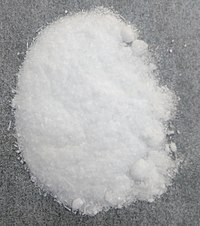Chemistry:Lanthanum acetate
This article needs attention from an expert in Chemicals. (April 2023) |

| |
| Names | |
|---|---|
| Other names
lanthanum(3+);acetate, lanthanum triacetate
| |
| Identifiers | |
3D model (JSmol)
|
|
| ChemSpider | |
| EC Number |
|
PubChem CID
|
|
| UNII | |
CompTox Dashboard (EPA)
|
|
| |
| |
| Properties | |
| C6H9LaO6 | |
| Molar mass | 316.039 g/mol |
| Appearance | colorless crystals |
| Density | g/cm3 |
| soluble | |
| Hazards | |
| GHS pictograms |  
|
| GHS Signal word | Danger |
Except where otherwise noted, data are given for materials in their standard state (at 25 °C [77 °F], 100 kPa). | |
| Infobox references | |
Lanthanum acetate is an inorganic compound, a salt of lanthanum with acetic acid with the chemical formula La(CH
3COO)
3.[1]
Synthesis
Lanthanum acetate can be formed by the reaction of lanthanum(III) oxide and acetic anhydride:
- La
2O
3 + 3(CH
3CO)
2O → 2La(CH
3COO)
3
- La
It is also made in a reaction of lanthanum oxide with 50% acetic acid:
- La
2O
3 + 6CH
3COOH → 2La(CH
3COO)
3 + 3H
2O
- La
Physical properties
Lanthanum(III) acetate forms colorless crystals.
Lanthanum acetate dissolves in water.
Lanthanum acetate forms hydrates of the composition La(CH
3COO)
3•nH
2O, where n = 1 and 1.5.[2][3]
Lanthanum acetate and its hydrates decompose when heated.
Uses
Lanthanum acetate is used in specialty glass manufacturing and in water treatment.
Also, it is used to produce porous lanthanum oxyfluoride (LaOF) films.[4]
It is also used as a component in the production of ceramic products and as a catalyst in the pharmaceutical industry.
References
- ↑ (in en) User guide and indices to the initital inventory, substance name index. U.S. Government Printing Office. 1979. p. 856. https://books.google.com/books?id=PCwBQIhLMrsC&dq=lanthanum(III)+acetate&pg=PA856. Retrieved 20 March 2023.
- ↑ "Lanthanum(III) acetate hydrate | Lanthanum Triacetate Hydrate | C6H11LaO7". Ereztech. https://ereztech.com/product/lanthanumiii-acetate-hydrate-100587-90-4/.
- ↑ "15299 Lanthanum(III) acetate sesquihydrate, 99.9% (REO)". Alfa Aesar. https://www.alfa.com/en/catalog/015299/.
- ↑ Shimoda, Tatsuya (5 February 2019) (in en). Nanoliquid Processes for Electronic Devices: Developments of Inorganic Functional Liquid Materials and Their Processing. Springer. p. 498. ISBN 978-981-13-2953-1. https://books.google.com/books?id=LciGDwAAQBAJ&dq=lanthanum(III)+acetate&pg=PA498. Retrieved 20 March 2023.
Acetyl halides and salts of the acetate ion
| |||||||||||||||||||
|---|---|---|---|---|---|---|---|---|---|---|---|---|---|---|---|---|---|---|---|
| AcOH | He | ||||||||||||||||||
| LiOAc | Be(OAc)2 BeAcOH |
B(OAc)3 | AcOAc ROAc |
NH4OAc | AcOOH | FAc | Ne | ||||||||||||
| NaOAc | Mg(OAc)2 | Al(OAc)3 ALSOL Al(OAc)2OH Al2SO4(OAc)4 |
Si | P | S | ClAc | Ar | ||||||||||||
| KOAc | Ca(OAc)2 | Sc(OAc)3 | Ti(OAc)4 | VO(OAc)3 | Cr(OAc)2 Cr(OAc)3 |
Mn(OAc)2 Mn(OAc)3 |
Fe(OAc)2 Fe(OAc)3 |
Co(OAc)2, Co(OAc)3 |
Ni(OAc)2 | Cu(OAc)2 | Zn(OAc)2 | Ga(OAc)3 | Ge | As(OAc)3 | Se | BrAc | Kr | ||
| RbOAc | Sr(OAc)2 | Y(OAc)3 | Zr(OAc)4 | Nb | Mo(OAc)2 | Tc | Ru(OAc)2 Ru(OAc)3 Ru(OAc)4 |
Rh2(OAc)4 | Pd(OAc)2 | AgOAc | Cd(OAc)2 | In | Sn(OAc)2 Sn(OAc)4 |
Sb(OAc)3 | Te | IAc | Xe | ||
| CsOAc | Ba(OAc)2 | Hf | Ta | W | Re | Os | Ir | Pt(OAc)2 | Au | Hg2(OAc)2, Hg(OAc)2 |
TlOAc Tl(OAc)3 |
Pb(OAc)2 Pb(OAc)4 |
Bi(OAc)3 | Po | At | Rn | |||
| Fr | Ra | Rf | Db | Sg | Bh | Hs | Mt | Ds | Rg | Cn | Nh | Fl | Mc | Lv | Ts | Og | |||
| ↓ | |||||||||||||||||||
| La(OAc)3 | Ce(OAc)x | Pr | Nd | Pm | Sm(OAc)3 | Eu(OAc)3 | Gd(OAc)3 | Tb | Dy(OAc)3 | Ho(OAc)3 | Er | Tm | Yb(OAc)3 | Lu(OAc)3 | |||||
| Ac | Th | Pa | UO2(OAc)2 | Np | Pu | Am | Cm | Bk | Cf | Es | Fm | Md | No | Lr | |||||
 |

